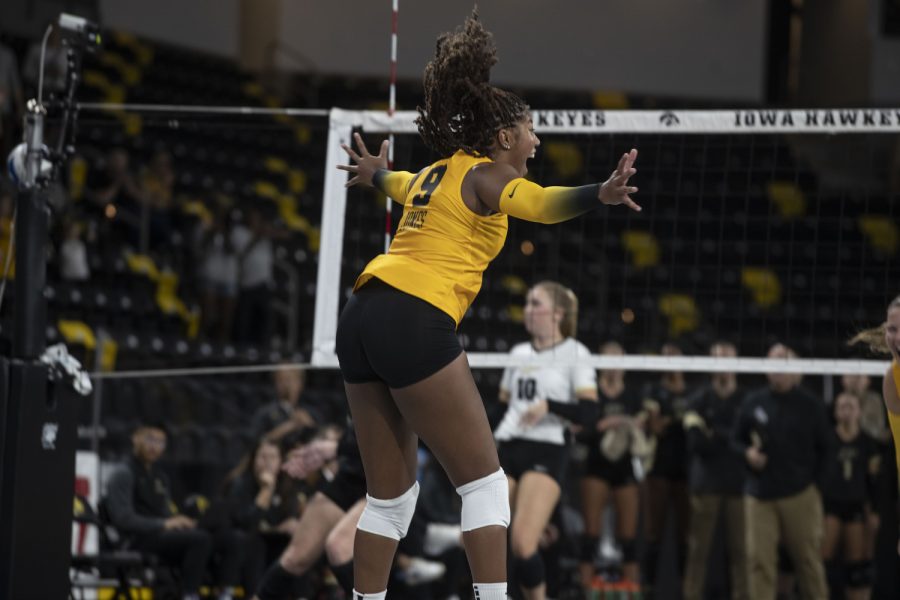The Iowa athletics department has distinguished itself in more ways than one this year. For the first time in 18 years, the Hawkeye football team beat a squad ranked in the AP top five when it downed Penn State, 24-23, on Nov. 8, 2008. Iowa wrestling won its second-straight national championship.
The women’s field-hockey team made it to the Final Four.
But perhaps the biggest accomplishment took place off the fields and courts. Because of the recession, colleges and uiversities all across the nation are slashing nonrevenue sports. Except for Iowa. In fact, not only is the Hawkeye athletics department self-sustaining (no help from student fees and the general fund), its budget continues to go up.
With the strong numbers, Iowa Athletics Director Gary Barta recognizes that much of the credit belongs to those in the stands.
“I’m not the one determining how much revenue [the revenue-producing sports] bring in,” he said. “That is determined by the fans who come out and attend those events. It’s created by supply and demand of people who are interested in coming to those sports.”
And Iowa is known for having loyal fans. In January, roughly 20,000 Hawkeye fans made the trip to Tampa for the Outback Bowl despite their tight wallets. The game was a sellout in each of Iowa’s two previous trips (2003 and 2005) to the bowl, helping Iowa’s cause for the bid in 2009.
That’s not to say Barta isn’t challenged by the occasional budget cut.
The goal in making budget cuts is to spend less and earn more, despite 30 years of constant growth in the number of teams and student-athletes in the NCAA.
The most common way of dealing with budget problems in athletics departments is to cut jobs, increase student athletics fees, pull athletics scholarships, and, in extreme cases, kick programs to the curb.
Iowa has yet to take such actions.
The primary financial goal of the Hawkeye athletics department is to “create a budget that is self-sustaining,” Barta said. In order to do so, the department has to produce more revenue than it plans on spending during each school year.
“Usually, you try to have a cushion there and try to make a little bit more revenue there than your expenses,” Barta said.
The program measures its success by two standards — marketing income and attendance. The sports marketing income has increased moderately each of the past five years with the exception of 2005-06, when it went down 0.2 percent.
In fact, the athletics department noted that in its five-year plan released in April 2008, its goal was to “grow revenue in all sports in which tickets are sold.” Iowa sells tickets for football, men’s and women’s basketball, baseball, softball, field hockey, volleyball, and wrestling.
During basketball season, the athletics department continued a project used during the 2006 football season it had hoped would catch on in order to increase attendance — printable, “in-house” tickets purchased online.
However, Iowa’s athletics budget doesn’t even rank in the top half of the Big Ten conference.
The Hawkeyes ranked sixth out of 10 schools (Penn State’s budget was unavailable) in the Big Ten, according to the athletics department’s five-year strategic budget plan. Ohio State, the school with the highest budget in the conference, budgeted $109.9 million for its athletics department in 2007-08.
When budgets are tight, a sport that is likely one of the first to receive the ax is wrestling.
Wrestling has seen its popularity dwindle over the past decade nationwide. Despite its devout following throughout the Midwest and Northeast — and especially in Iowa — only 87 programs remain at the Division-I level.
The Big 12, for example, boasts just five wrestling squads — Iowa State, Nebraska, Missouri, Oklahoma, and Oklahoma State.
The SEC has none.
Arizona State dropped its wrestling program in May 2008 to free up room in the school’s athletics budget, only to have it resurrected in a little more than two weeks after a spirited push from alumni and boosters collectively raised more than $1 million.
Wrestling isn’t the only sport feeling the heat of the staggering economy. Baseball is another.
Northern Iowa Athletics Director Tim Dannen announced Feb. 23 that the Panther baseball program was going to be dropped from the school’s varsity sports for financial purposes.
Rick Heller, the Northern Iowa baseball coach, and a group of alumni and former players objected to the decision. The group and several other people from around the state who cared about the program showered Iowa Gov. Chet Culver, the state Board of Regents, and Dannen with hundreds of e-mails, letters and phone calls.
“We offered to raise basically every penny,” Heller said.
Dannen created an April 5 deadline to come up with $1.2 million to save the program for three seasons. A committee of alumni, friends, and financial supporters promised to raise at least $250,000 on a yearly basis in order to finance the program. The committee proposed that Northern Iowa contribute $100,000 from its scholarship fund on an annual basis for a total budget of at least $350,000.
But the efforts came to no avail; Dannen rejected the proposal from the support group.
Heading into the 2010 baseball season, Iowa head coach Jack Dahm and his team will be the only Division-I baseball program in the state — Iowa State dropped its program in 2001.
“A lot of people are like, ‘Oh, is that a good thing for you?’”Dahm said. “But I don’t see any positives in [Northern Iowa and Iowa State] not having baseball. It takes opportunities away from kids in the state of Iowa.”
But other schools are making even more drastic decisions.
For the first time since Northeastern Illinois in 1998, a Division-I athletics department is in serious danger of being wiped out completely. The University of New Orleans is currently considering cutting its entire athletics department in order to deal with budget cuts.
Facing a $1.4 million deficit for the next fiscal year, the University of New Orleans athletics will depend on pending cuts by the university in order to survive. Under a proposal by Louisiana Gov. Bobby Jindal, the school must cut $15.3 million, including $1.4 million that the school gave the athletics department last year from its general fund.
On May 1, University of New Orleans students voted 1,418 to 1,251 against an increase in athletics fees, which likely dooms the Privateers’ hopes of salvaging their athletics department.
Other schools are also making cuts.
The University of Washington announced on May 1 it would eliminate its swimming teams to save as much as $1.2 million. However, getting rid of the entire program accounts for less than half of the spending that the athletics department needs to reduce.
The University of Massachusetts dropped its ski teams.
The University of Cincinnati got rid of scholarships for three men’s sports: cross-country, swimming, and track and field.
Stanford University ditched fencing.
With programs being cut across the nation, the future of Iowa athletics is largely dependent on the fans.
“[The economy] affects what we do because, obviously, 100 percent of our budget is driven by making the choice to come to our games, watch games on television, listen on the radio, buy the merchandise, come to the actual arena or the stadium,” Barta said. “If people have less discretionary income to spend, then it definitely affects what we do.”






